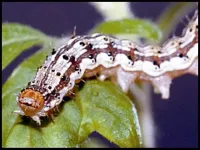(Press-News.org) UNIVERSITY PARK, Pa. -- Like a scene from a horror movie, tomato fruitworm caterpillars silence their food plants' cries for help as they devour their leaves. That is the finding of a multidisciplinary team of researchers, who said the results may yield insights into the abilities of crop plants -- such as tomato and soybean -- to withstand additional stressors, like climate change.
"We have discovered a new strategy whereby an insect uses saliva to inhibit the release of airborne plant defenses through direct manipulation of plant stomata," said Gary Felton, professor and head of the Department of Entomology at Penn State, noting that stomata are tiny pores on plant leaves that regulate gas exchange, including plant defensive emissions and carbon dioxide, between the plant and the environment.
Specifically, the researchers studied the effects of a particular enzyme -- glucose oxidase (GOX) -- that occurs in the saliva of tomato fruitworm caterpillars (Helicoverpa zea) on plant stomata and plant defensive emissions, called herbivore-induced plant volatiles (HIPV).
"HIPVs are thought to help protect plants from insect herbivores by attracting natural enemies of those herbivores and by alerting neighboring plants to the presence of herbivores nearby," Felton said. "Consequently, stomatal closure has the potential to alter interactions across the entire plant community."
In their experiments, the researchers used CRISPR/Cas9, a technique for editing genomes, to produce caterpillars that lack the GOX enzyme. In separate glass chambers fitted with filter traps to collect HIPVs, they allowed the caterpillars with the non-functional enzyme, along with unmanipulated caterpillars, to feed on tomato, soybean and cotton plants for three hours. To examine the stomatal response to GOX, the team examined the plant leaves under a microscope and measured the size of the stomatal openings. Next, they extracted the volatile compounds from the filter traps and used gas chromatography, coupled with mass spectrometry, to identify and quantify the HIPVs.
"This study is the first to use CRISPR/Cas9-mediated gene editing to study the function of an insect salivary enzyme," said Po-An Lin, a graduate student in entomology at Penn State and the lead author of the paper. "Using pharmacological, molecular, and physiological approaches, we were able to show that this salivary enzyme plays a key role in insect-induced stomatal closure and likely the reduction of several important defensive emissions."
Indeed, the team -- comprising experts in molecular biology, chemical ecology, plant physiology and entomology -- found that GOX, secreted by the caterpillar onto leaves, causes stomatal closure in tomato plants within five minutes, and in both tomato and soybean plants for at least 48 hours. They also found that GOX inhibits the emission of several HIPVs during feeding, including (Z)-3-hexenol, (Z)-jasmone and (Z)-3-hexenyl acetate, which are important airborne signals in plant defenses. Interestingly, they did not find an effect of GOX on the cotton plants, which, the team said, suggests that the impacts of GOX on stomatal conductance is species dependent.
The team's results appeared in the Jan. 18 issue of New Phytologist.
Lin noted that the fact that tomato fruitworm caterpillars evolved a salivary enzyme that inhibits emissions of defensive volatiles in certain species suggests the importance of plant airborne defenses in the evolution of insect herbivores.
"Given the ubiquity of HIPVs in plants, it is likely that traits which influence HIPVs have evolved broadly among insect herbivores," he said.
Not only do these insects damage individual plants, but they also may render them less able to withstand climate change.
"Stomata are important organs of plants that not only detect and respond to environmental stressors, but also play a central role in plant growth," said Felton. "Because stomata play an important role in regulating leaf temperature and leaf water content, our findings suggest that the control of stomatal opening by an insect could impact the plant's response to elevated temperatures occurring with climate change and response to water deficiency."
INFORMATION:
Other Penn State authors on the paper include Yintong Chen, graduate student in molecular, cellular and integrative biosciences; Chan Chin Heu, a former postdoctoral researcher; Nursyafiqi Bin Zainuddin, graduate student in entomology; Jagdeep Singh Sidhu, graduate student in horticulture; Michelle Peiffer, research support assistant in entomology; Ching-Wen Tan, postdoctoral scholar in entomology; Jared Ali, assistant professor of entomology; Jason L. Rasgon, professor of entomology and disease epidemiology; Jonathan Lynch, Distinguished Professor of Plant Science; and Charles T. Anderson, associate professor of biology. Also on the paper are Duverney Chaverra-Rodriguez, postdoctoral scholar, University of California, San Diego; Anjel Helms, assistant professor of chemical ecology, Texas A&M University; and Donghun Kim, assistant professor, Kyungpook National University.
The National Science Foundation, Agricultural and Food Research Initiative Program of the United States Department of Agriculture and a Hatch Project Grant supported this research.
Wheat straw, the dried stalks left over from grain production, is a potential source of biofuels and commodity chemicals. But before straw can be converted to useful products by biorefineries, the polymers that make it up must be broken down into their building blocks. Now, researchers reporting in ACS Sustainable Chemistry & Engineering have found that microbes from the guts of certain termite species can help break down lignin, a particularly tough polymer in straw.
In straw and other dried plant material, the three main polymers -- cellulose, hemicelluloses and lignin -- are interwoven into a complex 3D structure. The first two polymers are polysaccharides, which can be broken down into sugars and then converted to fuel in bioreactors. ...
Humans, like most social animals, tend to be organized hierarchically. In any group or social relationship there are always individuals who, for various reasons, significantly influence the behaviour of others. These individuals are attributed the highest status within the social group they belong to. As everyday examples of hierarchical relationships we find those of parents and children, teachers and students, bosses and workers, etc.
Given the pervasiveness of such social organization, in recent years studies have begun to ascertain how and when children begin to recognize which people have higher and which have lower social status. Specifically, ...
Prolonged anesthesia, also known as medically induced coma, is a life-saving procedure carried out across the globe on millions of patients in intensive medical care units every year.
But following prolonged anesthesia--which takes the brain to a state of deep unconsciousness beyond short-term anesthesia for surgical procedures--it is common for family members to report that after hospital discharge their loved ones were not quite the same.
"It is long known that ICU survivors suffer lasting cognitive impairment, such as confusion and memory loss, that can languish for months and, in some cases, years," said Michael Wenzel, MD, lead author of a study published in PNAS this month that documents changes associated with prolonged anesthesia in the brains of mice.
Wenzel, a former ...
The Mongolian Cyclone is a major meteorological driving force across southeast Asia. This cyclone is known for transporting aerosols, affecting where precipitation develops. Meteorologists are seeking ways to improve seasonal prediction of the relationship between the Mongolian cyclone and South Asia high. These features are major components of the East Asian summer monsoon (EASM) and the corresponding heavy rain events. New research suggests that analyzing these phenomena in the upper-level atmosphere will enhance the summer rainfall forecast skill in China.
"The lower seasonal predictability of EASM may happen when the coupling wheel of Mongolian cyclone and South Asia high prevails over East Asia." said Prof. ...
The unique properties of rare earth (RE) complexes including ligand-sensitized energy transfer, fingerprint-like emissions and long-lived emissions, make them promising materials for many applications, such as optical encoding, luminescence imaging/sensing and time-resolved luminescence detection. In particularly, the use of RE luminescent materials for in vitro and in vivo imaging can easily eliminate the autofluorescence of organisms and any interference from background fluorescence. However, most RE complexes have poor solubility and stability in aqueous solution and their luminescence can be easily quenched by nearby X-H (X ...
A large-scale study of the link between innovation and financial performance in Australian companies has found more innovative companies post higher future profits and stock returns.
The findings highlight the significant financial benefits of innovation for companies, which in turn supports job creation and economic growth.
The study, conducted by Dr Anna Bedford, Dr Le Ma, Dr Nelson Ma and Kristina Vojvoda from the University of Technology Sydney, examined patent registrations from 1296 ASX-listed companies between 1997 and 2018.
They matched patent data with ...
After more than 1,000 orthopaedic procedures at a city health system, roughly 61 percent of the opioids prescribed to patients went unused, according to new research. This was discovered within a study at the Perelman School of Medicine of the University of Pennsylvania that showed most patients responded to text messages designed to gauge patients' usage of their prescriptions. Knowing that so many patients are comfortable texting this information to their care teams is extremely useful as medical professionals look to right-size painkiller prescriptions and reduce the amount of opioids that might be misused when they're left over. This study was published in NEJM Catalyst.
"This approach is a step toward building a dynamic learning health system that evolves ...
BOSTON -- Numerous studies have demonstrated the role of physical activity in improving heart health for patients with type 2 diabetes. But whether exercising at a certain time of the day promises an added health bonus for this population is still largely unknown. Now, research published in Diabetes Care by Brigham and Women's Hospital and Joslin Diabetes Center investigators, along with collaborators, reports a correlation between the timing of moderate-to-vigorous physical activity and cardiovascular fitness and health risks for individuals who have type 2 diabetes and obesity or overweight.
The research team found that, in its study of ...
A nasal antiviral created by researchers at Columbia University Vagelos College of Physicians and Surgeons blocked transmission of SARS-CoV-2 in ferrets, suggesting the nasal spray also may prevent infection in people exposed to the new coronavirus, including recent variants
The compound in the spray--a lipopeptide developed by Matteo Porotto, PhD, and Anne Moscona, MD, professors in the Department of Pediatrics and directors of the Center for Host-Pathogen Interaction--is designed to prevent the new coronavirus from entering host cells.
The antiviral lipopeptide is inexpensive to produce, has a long shelf ...
An engineered peptide given to ferrets two days before they were co-housed with SARS-CoV-2-infected animals prevented virus transmission to the treated ferrets, a new study shows. The peptides used are highly stable and thus have the potential to translate into effective intranasal prophylaxis to reduce infection and severe SARS-CoV-2 disease in humans, the study's authors say. The SARS-CoV-2 spike (S) protein binds to host cells to initiate infection. This stage in the virus life history is a target for drug inhibition. Here, researchers with past success designing lipopeptide fusion inhibitors that block this critical first step of infection for SARS-CoV-2 and other viruses sought to design ...




